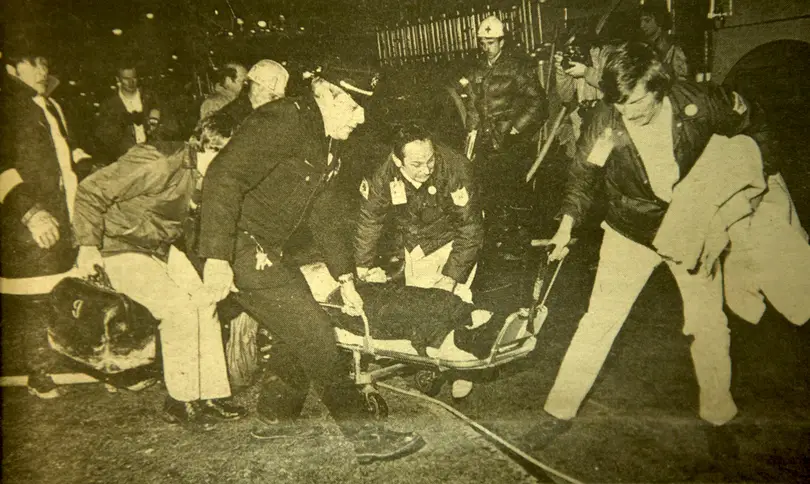Final alarm: Memory of fatal fire on University Avenue persists after 35 years
Janis Kraft still has a hard time lighting candles.
If she has to, she keeps them in the sink and constantly checks on them. It’s because of what happened 35 years ago, where the Martin J. Whitman School of Management stands today — a fatal fire in the student apartment where she lived.
“It has stuck with me my whole life,” she said.
Tuesday marks the 35th anniversary of the 701 University Ave. fire, which took the lives of four Syracuse firefighters — Stanley Duda, Michael Petragnani, Robert Schuler and Frank Porpiglio — in an 80-year-old student apartment building near the Syracuse University campus. The fire is still remembered today by those who experienced it: SU students, journalists and firefighters.
Kraft’s apartment was on the second floor. She was one of 14 SU students who lived in the building.
The sounds of banging on doors and screaming woke her up. Someone then grabbed her and brought her across the street, Kraft said.
The death of the four firefighters is the most important thing to remember from that day, she said. The firefighters thought there were still people inside of the building.
“I believe some of them knocked on my door,” Kraft said. “And they got me out — and saved my life.”
Cirsten Carle lived on the third floor and awoke to a crackling sound in her ears — something she later learned was the result of breathing in toxins from the fire.
It was extremely quiet, she said, and there was a light coming into the room. She tried turning on the lights but they didn’t go on, Carle said, and she noticed the floorboards were glowing.
“Nothing made sense to me at that point,” she said.
It was then Carle yelled for help out of the window. She got dressed, put her Martin sunburst guitar in the closet, grabbed her camera and went downstairs.
Carle ran into a firefighter coming up the stairs who asked her if there was anyone still inside the building. She said she didn’t know.
She said the event is still very emotional for her, something that’s evident in Carle’s voice.
“I almost feel guilty,” Carle said. “That it was my fault.” Though she would later learn the firefighters were required to enter the building.
The fire was widely reported to have happened because a student left a candle burning unattended in one of the apartments.
But Carle said a law student told her the fire started because of a faulty electrical line that was installed by someone who wasn’t an electrician. This is something she didn’t tell the fire investigators because she only found out after she had been interviewed.
With a lot of emotion in her voice, she recalled the moment when she saw the bodies of the firefighters being taken out on stretchers.
The firefighters’ funerals were held in the Cathedral of Immaculate Conception in downtown Syracuse. More than 2,000 people — including 1,500 uniformed firefighters from 40 departments as far away as Philadelphia and Boston — attended.
The cathedral only sat 1,200 people, and many had to watch the service on televisions in the Onondaga County War Memorial, reported The Syracuse Herald-Journal on April 12, 1978. A service was also held in Hendricks Chapel.
Glen Ellman photographed the fire for The Post-Standard and The Daily Orange, and also took pictures of the service.
He described the ceremony as “unbelievably emotional,” and remembers taking a picture of one of the firefighters’ widows being given a flag.
“I still see that picture and I still think about that,” Ellman said. “I said, ‘I never, ever want to do this again.’”
As a commercial photographer who works for the fire department in Fort Worth, Texas, Ellman has had to photograph funerals there, as well as some after Sept. 11. But he said he still thinks about the University Avenue fire.
Deputy Chief Dave Reeves wasn’t on duty the night of the fire, but was scheduled to work the next day. When he turned on the radio and heard the news, he said he felt a pit in his stomach that was impossible to describe.
He joined the Syracuse Fire Department in 1973 and was a city firefighter at Engine Company 7, which serves the Hill and surrounding area.
Reeves said he was close friends with Petragnani and Duda, two of the firefighters who died. He had also worked with Porpiglio and had just met Schuler.
“It’s always difficult to lose a colleague that you’ve sat [with] at a picnic table in their backyard,” Reeves said. “It’s anguishing.”
Many firefighters transferred because the memory of the fire was too painful, he said. Others spent the rest of their lives trying to fill the hole it left behind.
In 2005, a plaque honoring the lives of the firefighters was placed in Whitman. Reeves helped design it.
The lessons from the fire aren’t lost, he said, and new mayday and communications procedures were developed. A report on the fire was re-issued a few years ago, and the department tries to make sure there’s awareness about what happened, he said.
Thirty-five years later, though, it’s still critical to remember that the men who lost their lives aren’t just names on a monument, he said.
“Never forget,” Reeves said, echoing the call that followed Sept 11. “There’s where we want to be with this — we never want to forget these guys.”
Published on April 9, 2013 at 12:49 am
Contact Dylan: [email protected] | @dylan_segelbaum






